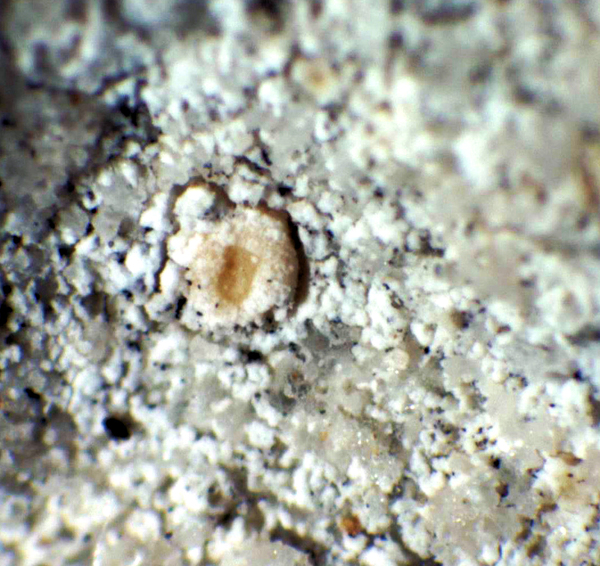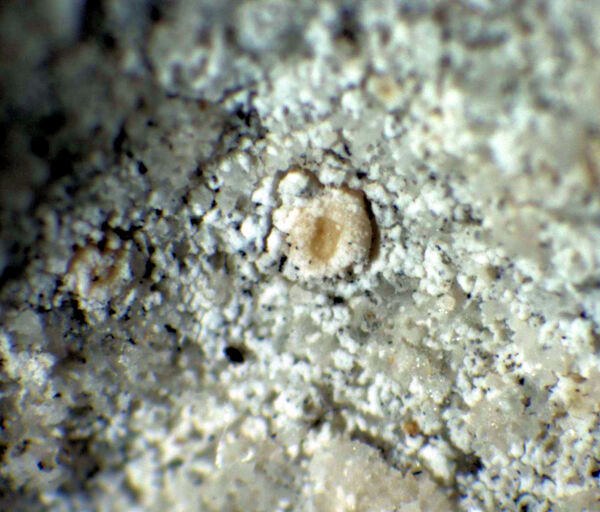Polyozosia poeltiana (Clauzade & Cl. Roux) S.Y. Kondr., Lőkös & Farkas
in Kondratyuk & al., Acta Bot. Hung., 62, 1-2: 103, 2020. Basionym: Lecanora poeltiana Clauzade & Cl. Roux - Beih. Nova Hedwigia, 79: 188, 1984.
Synonyms: Lecanora lactea sensu Clauzade & Cl. Roux non (A. Massal.) Leight.; Myriolecis poeltiana (Clauzade & Cl. Roux) Śliwa, Zhao Xin & Lumbsch
Distribution: C - Sar. S - Camp (Nimis & Tretiach 2004, Garofalo & al. 2010), Pugl (Nimis & Tretiach 1999).
Description: Thallus crustose, episubstratic, rimose or rimose-areolate, white to beige, slightly farinose, 0.1-0.3 mm thick, forming well-delimited small patches 0.5-2(-3) cm in diam. Areoles flat, 0.3-0.8(-1) mm wide, angular, the marginal ones sometimes weakly radiating. Apothecia lecanorine, 0.3-0.5 mm across, usually crowded and sometimes partly confluent, at first immersed in the thallus, then sessile, with a slightly concave to slightly convex, pale reddish brown, epruinose, sometimes umbonate disc, and a thick but hardly raised, smooth thalline margin. Thalline exciple corticate, rich in crystals visible under polarized light; epithecium brown, inspersed with small crystals visible under polarized light; hymenium colourless, 45-60 μm high, also inspersed throughout with crystals, I-; paraphyses simple or sparingly branched in upper part, c. 2 μm thick at base, the apical cells c. 4 μm wide; hypothecium colourless. Asci 8-spored, elongate-clavate, very thin-walled, with a K/I+ blue, tall tholus penetrated by a faintly amyloid apical cushion, the wall K/I-, surrounded by a K/I+ blue outer layer, Lecanora-type. Ascospores 1-celled, hyaline, subglobose to ellipsoid, 7-12 x 5-7 μm. Photobiont chlorococcoid. Spot tests: thallus K-, C-, KC-, P-, UV-; apothecial disc C+ and KC+ pink. Chemistry: without lichen substances, or (fide Cl. Roux, in litt.) apothecia with variable amounts of gyrophoric acid. Note: on hard, compact calcareous rocks under the influence of salt-spray; probably more widespread, but certainly not common, along the Mediterranean coast. For the differences from other littoral species of Polyozosia see Bertrand & al. (2010).
Growth form: Crustose
Substrata: rocks
Photobiont: green algae other than Trentepohlia
Reproductive strategy: mainly sexual
Taxon bound to maritime-coastal situations
Commonnes-rarity: (info)
Alpine belt: absent
Subalpine belt: absent
Oromediterranean belt: absent
Montane belt: absent
Submediterranean belt: absent
Padanian area: absent
Humid submediterranean belt: absent
Humid mediterranean belt: very rare
Dry mediterranean belt: very rare

Predictive model
Herbarium samples
Growth form: Crustose
Substrata: rocks
Photobiont: green algae other than Trentepohlia
Reproductive strategy: mainly sexual
Taxon bound to maritime-coastal situations
Commonnes-rarity: (info)
Alpine belt: absent
Subalpine belt: absent
Oromediterranean belt: absent
Montane belt: absent
Submediterranean belt: absent
Padanian area: absent
Humid submediterranean belt: absent
Humid mediterranean belt: very rare
Dry mediterranean belt: very rare

Predictive model
| Herbarium samples |





